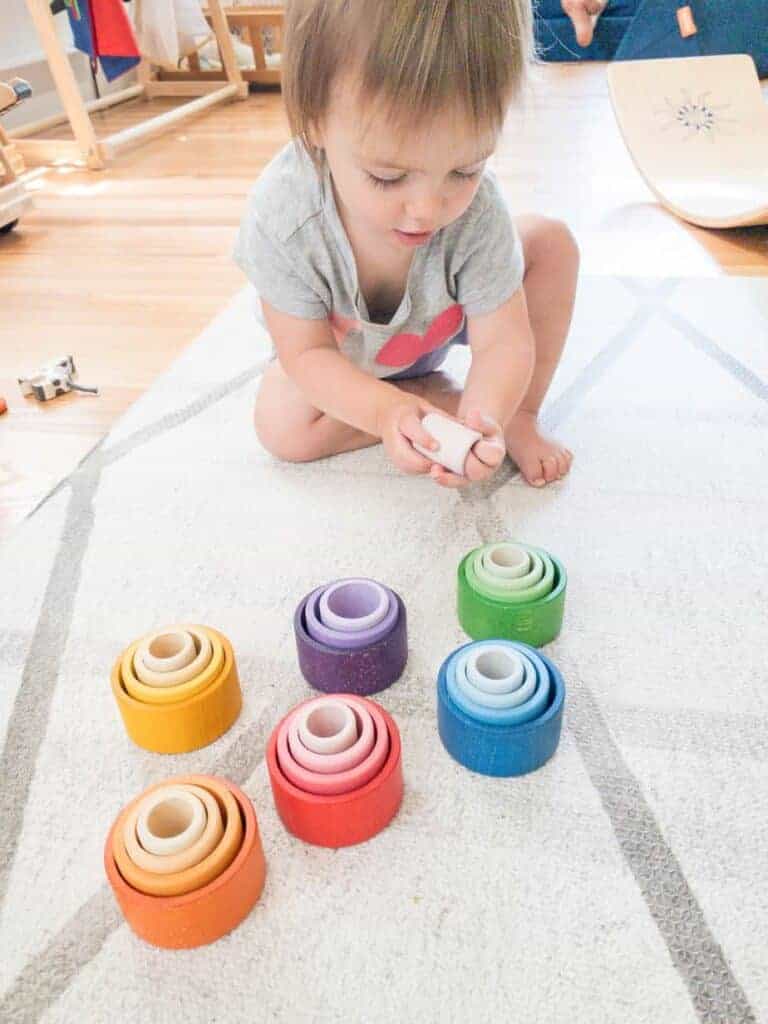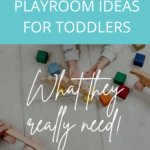Playroom Ideas For Toddlers: What They Really Need!
When it comes to playrooms for toddlers, less is more. Many parents make the mistake of filling their toddler's playroom with every toy and gadget imaginable, but this can actually be counterproductive. In reality toddlers (and kids in general) need much less than what we think they do. Toddlers especially need a space that is simple, calming, and encourages independence. Here are some simple playroom ideas for toddlers!

Playroom ideas: 7 things a toddler must have
- Minimal toys: A few good-quality toys are all your toddler needs. Too many toys can be overwhelming and actually inhibit play. Focus on toys like wooden stacking toys and nesting cups, a simple dump truck for filling and dumping which is a toddler favorite, larger loose parts (stay away from smaller pieces as they can be a choking hazard), a set of colorful wooden blocks, and toys that encourage gross motor play.
- Open space: The playroom should be a space where your child can explore, play, and learn on their own. Try to avoid filling it with too much furniture or other distractions (and don't hate me but… no screens please!). It's important to have a clean and organized open space as having that sense of openness is inviting vs overwhelming. That doesn't mean the space needs to be physically large, it just needs to be open, bright, and not full of clutter.
- Furniture: If you do have furniture make sure that it is something you are OK with your little one climbing and jumping on–toddlers are built to move and you don't want to spend your whole day saying “Get off the couch” or “No, you can't jump on that!” Consider adding some pieces like a Nugget, pikler triangle, or swing that will give your toddler an outlet for movement!
- Colors and textures: As your child's senses are awakening, it's important to use colors and textures in the playroom that will stimulate them. Bright colors, simple patterns, and different textures will help keep their attention and encourage exploration. That doesn't mean everything in the playroom needs to be flashy and bold primary colors. Toys and decor should be simple, and beautiful to look at when possible!
- Natural light: Sunlight is a natural energizer (not that toddlers need more energy). When selecting a space for a play area try to find a space that gets good light. Skip the window treatments, like curtains, blackouts, or shades.
- Plenty of storage: It's important to have plenty of storage in the playroom so that toys can be put away when playtime is over. This will help keep the space clean and organized, which is especially important for toddlers who are still learning about boundaries and limits. You want to make sure to use open storage that is at their level so they can easily access everything without help–this will help promote independence. Keeping each type of toy in its own place will also help children learn to put things back. In our house we talk about everything having its own home–we focus on making sure we are always putting things back in their home where they belong.
- Window seat: A window seat is a great addition to any space in general. If you have a room with a window seat that is a great space for a playroom! Toddlers LOVE looking outside. Regardless of your view–children will find beauty in just about anything! Let them look for birds, cars, clouds…This will keep them busy for hours.
Play. Learn. Thrive.™ only endorses products we authentically love and use. Some of the product links in this post may be affiliate links. That means that if you click them and make a purchase, this site makes a commission. Play. Learn. Thrive.™ is also an Amazon Associate. As an Amazon Associate, we earn from qualifying purchases. It will have no impact on the price you pay or the experience of your purchase.
I know the toy advertisers want you to think that each year your child grows they need new toys. There are many toys that work from the infant years through the preschool years and beyond. Imagine not having to spend money on new toys every year to keep your child “happy, entertained, and learning.” When you invest your money in toys that are good for many different age groups, then you save significant money in the long run. Win-win.
Toys that can span multiple age groups are often not toys you will see at the checkout aisle or traditional toy store.
8 toys to put in a toddler playroom (and why!)

Stacking toys: Stacking toys are a great toy for all ages! Not only do they help with hand-eye coordination and fine motor skills, but they can also be used for counting, sorting, and naming colors.

Simple wooden blocks: Wooden blocks have been around for years because they are such a versatile toy. They can be stacked, sorted, built into towers, used for counting, and more. No, your toddler will probably not start building intricate block castles. Here is how wooden blocks WILL go for toddlers. They will typically start to use a wooden block as a teething toy (wood is a natural antimicrobial), then start to hit the blocks together to make music, then they might start throwing (this is called the trajectory schema!), then typically they will start doing things like lining them up, stacking (and knocking down), and then eventually building through the preschool years and beyond.

Playdough: Playdough is another toy that can be enjoyed by all ages. It helps with hand-eye coordination, creativity, and fine motor skills. It's also a super simple sensory experience for children. Give them wooden or silicone playdough tools, cookie cutters, or small vehicles to encourage imaginative play.

Nesting Bowls: Nesting bowls are another toy that can be used from infancy through the preschool years. Similar to wooden blocks, nesting bowls help with hand-eye coordination, counting, and sorting. They eventually become a pouring tool and are used to stack (and again probably knock over).

Sensory Table: A sensory table is a great investment for any playroom. It can be used for infants through the preschool years and beyond. Fill it with water, rice, kinetic sand, or shaving cream to provide a stimulating sensory experience.

Loose Parts: Loose parts are simply pieces of materials that can be used in many different ways. Some examples are feathers, pipe cleaners, googly eyes, cardboard tubes, and more. Loose parts help with creativity, fine motor skills, and problem-solving skills.

Cars and trucks: Cars and trucks are classic toys that span all ages. Toddlers love to play with them by zooming them around, loading them up, and then dumping them. They help encourage imaginative play, social skills, and dexterity.

Gross motor toys: Toys that allow toddlers to climb and move their bodies are a must. The pikler triangle, Nugget, stepping stones, balance beam, or balance board are all great options for gross motor play. Having access to these toys allows for children to develop a good sense of balance and coordination. Gross motor toys also encourage healthy risk-taking. The pikler triangle is one of our favorite climbing toys because it is simple yet challenging for toddlers.
How to set up a playroom for toddlers
So what should you put in your toddler's playroom? The main thing is to keep it simple and calming. Stick to a few favorite toys, and make sure the space is free from distractions. This will encourage independence and help toddlers learn through exploration. With these tips in mind, you can create a playroom that supports your child's development.
Playroom Ideas for Toddlers
For more ideas and step-by-step instructions on how I recommend setting up a toddler’s playroom, check out The Ultimate Playroom Design.

